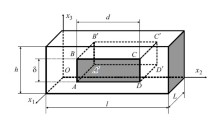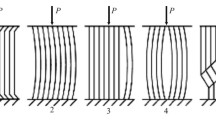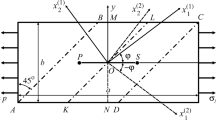Abstract
Creep strains in unidirectional organic-fiber-and organic-glass-fiber-reinforced plastics subject to tension in the reinforcement direction are predicted. Based on homogeneity condition and statistical criteria, it is shown that the creep of the composites is essentially nonlinear. To predict creep strains, use is made of a nonlinear creep model based on a modified Rabotnov’s similarity hypothesis for isochrones and of material constants determined from tests on specimens made of a composite as a whole and specimens made of its separate components, the mixing rule applied in the latter case. The calculated results and the experimental data are in satisfactory agreement
Similar content being viewed by others
References
A. S. Vol’mir, V. F. Pavlenko, and A. T. Ponomarev, “Use of composite materials in airframes,” Mech. Comp. Mater., 8, No. 1, 89–95 (1972).
V. P. Golub, Yu. M. Kobzar’, and P. V. Fernati, “Nonlinear creep of viscoelastic epoxy binders under tension,” Teor. Prikl. Mekh., 41, 91–97 (2005).
V. P. Golub, A. D. Pogrebnyak, and I. B. Romanenko, “Smoothing spline-approximations in the identification of creep parameters,” Prikl. Mekh., 33, No. 6, 52–61 (1997).
A. A. Ily’ushin and B. E. Pobedrya, “On the nonlinear theory of viscoelasticity,” in: Strength and Plasticity [in Russian], Nauka, Moscow (1971), pp. 270–276.
I. M. Kershtein, R. D. Stepanov, and P. M. Ogibalov, “Region of linearity of the deformation properties of contact-molded glass-reinforced plastic,” Mech. Comp. Mater., 6, No. 3, 343–348 (1970).
M. A. Koltunov, “Construction of the nonlinear relations of thermoviscoelasticity,” Mech. Comp. Mater., 3, No. 6, 652–656 (1967).
A. F. Kregers, “Nonpolynomial descriptions of the physical nonlinearity of viscoelastic materials,” Mech. Comp. Mater., 16, No. 5, 520–528 (1980).
R. D. Maksimov and É. Plumé, “Long-term creep of hybrid aramid/glass-fiber-reinforced plastics,” Mech. Comp. Mater., 37, No. 4, 271–280 (2001).
N. I. Malinin, “Some issues of the mechanics of composite materials and products,” Mekh. Komp. Mater., No. 5, 784–789 (1979).
P. M. Ogibalov and B. E. Pobedrya, “Nonlinear mechanics of polymers,” Mech. Comp. Mater., 8, No. 1, 8–17 (1972).
Yu. N. Rabotnov, Elements of the Hereditary Mechanics of Solids [in Russian], Nauka, Moscow (1977).
Yu. N. Rabotnov, A. Kh. Papernik, and E. I. Stepanychev, “Application of the nonlinear theory of heredity to the description of time effects in polymeric materials,” Mech. Comp. Mater., 7, No. 1, 63–73 (1971).
M. I. Rozovskii, “The application of nonlinear functionals to the construction of the equations of state of materials with memory,” Int. Appl. Mech., 6, No. 8, 812–816 (1970).
A. M. Skudra, F. Ya. Bulavs, and K. A. Rotsens, Creep and Static Fatigue of Reinforced Plastics [in Russian], Zinatne, Riga (1971).
E. A. Sokolov and R. D. Maksimov, “Possibilities of predicting the creep of a polymeric fiber-reinforced plastic from the properties of the components,” Mech. Comp. Mater., 14, No. 6, 807–813 (1978).
M. N. Stepnov, Statistical Methods for the Treatment of Mechanical Test Data [in Russian], Mashinostroenie, Moscow (1985).
Yu. V. Suvorova, “Taking temperature into account in hereditary theory of elastoplastic media,” Strength of Materials, 9, No. 2, 163–168 (1977).
Yu. V. Suvorova, “Nonlinear effects during the deformation of hereditary media,” Mech. Comp. Mater., 13, No. 6, 814–818 (1977).
Yu. V. Suvorova and S. I. Alekseeva, “Nonlinear model of an isotropic hereditary medium in state of complex stress,” Mech. Comp. Mater., 29, No. 5, 443–447 (1993).
Yu. V. Suvorova and S. I. Alekseeva, “Nonlinear hereditary model including temperature effects in various stress states,” Mech. Comp. Mater., 32, No. 1, 53–60 (1996).
Yu. M. Tarnopolskii, “Modern trends in the development of fibrous composites,” Mech. Comp. Mater., 8, No. 3, 473–481 (1972).
Yu. S. Urzhumtsev, Ch. A. Daugete, and A. V. Kalproze, “Nonlinear thermoviscoelasticity of polymeric materials belonging to the class of rheologically simple bodies,” Mech. Comp. Mater., 10, No. 5, 675–680 (1974).
T. Fujii and M. Zako, Fracture Mechanics of Composite Materials [Russian translation], Mir, Moscow (1982).
R. A. Schapery, “Viscoelastic behavior and analysis of composite materials,” in: Composite Materials, Vol. 2, Academic Press, New York, pp. 84–168 (1974).
L. Boltzmann, “Zur Theorie der elastischen Nachwirkung,” Ann. Phys. Chem., No. 7, 275–315 (1876).
W. Comboonsong, F. K. Ko, and H. G. Harris, “Ductile hybrid fiber reinforced plastic (FRP) rebar for Concrete structures: Design methodology,” ACI Mater. J., 95, No. 6, 232–239 (1998).
V. P. Golub, Yu. M. Kobzar’, and P. V. Fernati, “An approach to constructing of a rheological model of strain-hardening media,” Int. Appl. Mech., 40, No. 7, 776–784 (2004).
V. P. Golub, Yu. M. Kobzar’, and P. V. Fernati, “Calculating linear creep strains of viscoelastic fibers under tension,” Int. Appl. Mech., 41, No. 5, 543–551 (2005).
V. P. Golub, Yu. M. Kobzar’, and P. V. Fernati, “Nonlinear creep of viscoelastic organic fibers under tension,” Int. Appl. Mech., 41, No. 7, 793–804 (2005).
V. P. Golub, V. I. Krizhanovskii, A. D. Pogrebnyak, and A. V. Romanov, “A method of modeling the interaction of creep and high-cycle fatigue,” Int. Appl. Mech., 41, No. 1, 14–25 (2005).
A. A. Kaminskii and M. F. Selivanov, “A method for determining the viscoelastic characteristics of composites,” Int. Appl. Mech., 41, No. 5, 469–480 (2005).
R. Tepfers, V. Tamuzs, R. Apinis, U. Vilks, and J. Modniks, “Ductility of nonmetallic hybrid fibre composite reinforcement for concrete,” Mech. Comp. Mater., 32, No. 2, 167–179 (1996).
V. Volterra, Lecons sur les Fonctions de Lignes, Gauther-Villard, Paris (1913).
Author information
Authors and Affiliations
Additional information
__________
Translated from Prikladnaya Mekhanika, Vol. 43, No. 5, pp. 20–34, May 2007.
Rights and permissions
About this article
Cite this article
Golub, V.P., Kobzar’, Y.M. & Fernati, P.V. Nonlinear creep of unidirectional fibrous composites tensioned along the reinforcement. Int Appl Mech 43, 491–503 (2007). https://doi.org/10.1007/s10778-007-0046-2
Received:
Issue Date:
DOI: https://doi.org/10.1007/s10778-007-0046-2




